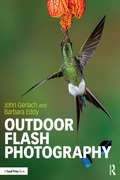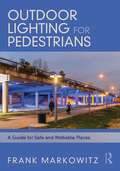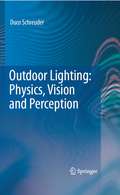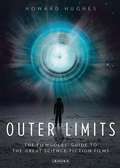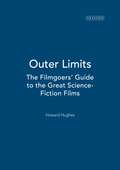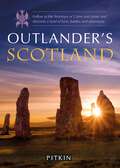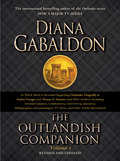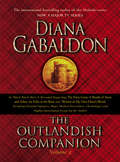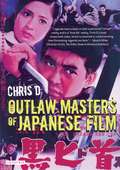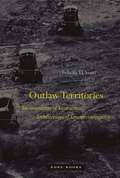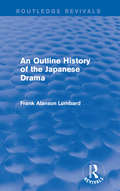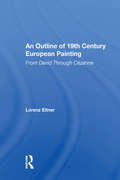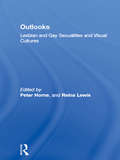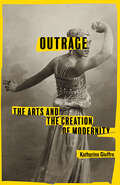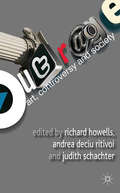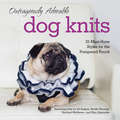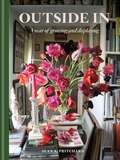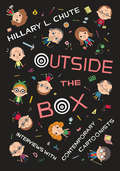- Table View
- List View
Outdoor Flash Photography
by John Gerlach Barbara EddyMaximizing the power of your camera’s flash is difficult enough in a studio set-up, but outdoors literally presents a whole new world of challenges. John Gerlach and Barbara Eddy have taken the most asked about subject from their renowned photography workshops and turned it into this guidebook that is sure to inspire your next outdoor shoot, while also saving you time and frustration. Outdoor Flash Photography covers a range of practices from portrait to landscape, including unique strategies that the authors have pioneered through 40 years in the field. Mastering the use of multiple flashes to freeze action is shown through one of most challenging subjects in nature, hummingbirds in flight. This book will benefit photographers of all experience levels who are eager to evolve their outdoor photography and get the most out of their equipment.
Outdoor Lighting for Pedestrians: A Guide for Safe and Walkable Places
by Frank MarkowitzOutdoor Lighting for Pedestrians shows how outdoor lighting is important for pedestrians’ safety, personal security, and comfort, with major impacts on street, path, and park aesthetics and neighborhood sense of place. Providing clear, basic technical background (accessible to non-engineers), the book focuses especially on planning and policy concerns. It covers the fundamentals of lighting technology; benefits, costs, and possible adverse impacts of lighting enhancements; traditional and innovative approaches; planning and policy documents and practices; aesthetics and placemaking; and technology trends in lighting design. This book is aimed primarily at practicing transportation planners and engineers, generalist urban planners, safety advocates and researchers, and university students. However, lighting designers and other professionals will also find it useful. It considers how lighting can be coordinated with other potential improvements to enhance the pedestrian environment for better walkability.
Outdoor Lighting for Pedestrians: A Guide for Safe and Walkable Places
by Frank MarkowitzOutdoor Lighting for Pedestrians shows how outdoor lighting is important for pedestrians’ safety, personal security, and comfort, with major impacts on street, path, and park aesthetics and neighborhood sense of place. Providing clear, basic technical background (accessible to non-engineers), the book focuses especially on planning and policy concerns. It covers the fundamentals of lighting technology; benefits, costs, and possible adverse impacts of lighting enhancements; traditional and innovative approaches; planning and policy documents and practices; aesthetics and placemaking; and technology trends in lighting design. This book is aimed primarily at practicing transportation planners and engineers, generalist urban planners, safety advocates and researchers, and university students. However, lighting designers and other professionals will also find it useful. It considers how lighting can be coordinated with other potential improvements to enhance the pedestrian environment for better walkability.
Outdoor Lighting: Physics, Vision and Perception
by Duco SchreuderThe present book is based on the experience of the author. The experience is mainly the result of years of research, of consulting work, and in participation in policy decision making in many felds, most, but not all, related to outdoor lighting. To some degree, the book represents the preference of the author. The selection of the subjects is based on more than 50 years of experience of what is desirable to know for persons engaged in scientifc research or practical application in the felds of lighting and vision. The subjects deal with a number of fundamental aspects. The theorists must have them at their fngertips, whereas the practical engineers may assume them as known in their daily work. The selection of subjects is based in part by the questions that came to the author over the years, but even more by the preference of the author himself. In this respect, it is a personal book. Thus, it should be stressed that the book is not a ‘handbook’ or even a ‘textbook’; many subjects that commonly are treated in such books are not included here. Not because they lack importance, but because the author feels that they are adequately treated elsewhere. Some relevant works are mentioned in the References. Over the years, the author has been engaged in giving courses on vision and lighting, lately more in particular on Masterclasses on a post-graduate or post-doctorate level.
Outer Limits: The Filmgoers’ Guide to the Great Science-Fiction Films
by Howard HughesScience Fiction is probably the most popular box office genre in movie history and has given filmgoers some of their most memorable cinematic experiences. Outer Limits takes its readers on a tour of the sci-fi cinema universe in all its fantastical, celestial glory.The milestone films of sci-fi cinema from Metropolis to Avatar are discussed in this Filmgoers' Guide for anyone who enjoys a cinema that has pleased and amazed filmgoers since the dawn of cinema. Illustrated with fine examples of sci-fi film poster-art, Outer Limits goes deep into the most interesting and popular movies across sci-fi cinema's many forms, with core chapters used as launch pads to discuss lesser-known influential movies and follow-on sequels. Howard Hughes tells the stories from pre-production to box office returns of The War of the Worlds, Independence Day, Tarantula, Godzilla, The Time Machine, The Thing, Invasion of the Body Snatchers, Forbidden Planet, Barbarella, Galaxy Quest, Minority Report, Planet of the Apes, Mad Max 2, Back to the Future, Alien, Terminator 2: Judgement Day, The Man Who Fell to Earth, The Matrix, Star Trek, Apollo 13, Blade Runner and many more.
Outer Limits: The Filmgoers’ Guide to the Great Science-Fiction Films
by Howard HughesHOWARD HUGHES'S NEW FILMGOERS' GUIDE TO SCIENCE-FICTION FILMS DELVES DEEP INTO THE LANDMARK MOVIES OF THIS EVERPOPULAR GENRE, FROM METROPOLIS TO AVATAR AND BEYOND, AND COVERS OVER 250 MORE Outer Limits explores science-fiction cinema through 26 great films, from the silent classic Metropolis to today. It reviews the galaxy of stars and directors who have created some of the most popular films of all time, including George Lucas's 'Star Wars' films, Steven Spielberg's Close Encounters of the Third Kind and Minority Report, James Cameron's 'Terminator' films and Ridley Scott's milestones Alien and Blade Runner. It also discusses everything from A-listers 2001: A Space Odyssey and Planet of the Apes, to Japanese monster movies, 1950s B-movies, creature features and cult favourites, depicting time travel, distant planets or alien invasions. Films featured include The War of the Worlds, Independence Day, Tarantula, Godzilla, The Thing, Forbidden Planet, Barbarella, Galaxy Quest, Mad Max 2, Back to the Future, The Man Who Fell to Earth, Star Trek, Apollo 13, Invasion of the Body Snatchers, The Matrix, and many, many more.Illustrated with original posters, Outer Limits is an informative, entertaining tour of the sci-fi universe.
Outlander's Guide to Scotland (Location Guides #2)
by Phoebe Taplin'One of the best guide books ... all that you need to ensure a thoroughly enjoyable do-it-yourself Outlander tour.' – Outlander Home Page 'Beautifully presented ... and the print quality of the book is top-notch.' – Scottish Field 'Billow and breeze, islands and seas, Mountains of rain and sun...' Since 18th-century Highland warrior Jamie Fraser and resourceful 20th century medic, Claire Randall first met on screen in 2014, millions of viewers have been swept away by the Outlander TV series to the wild hills and craggy castles of Scotland. Now you can follow in the footsteps of Claire and Jamie with this guide to the inspiring locations where Diana Gabaldon's novels were set and the hit tv show were filmed. From the ancient cobbled streets, gabled palace and herb garden of Culross, which became fictional Cranesmuir, to the iconic 1960s Pathfoot Building at the University of Stirling, which Claire's daughter Brianna visits on her first trip to Scotland, you can time-travel through centuries. In Scotland, different eras coexist and collide – just as they do in Outlander. Focusing on easy day trips from the characterful cities of Edinburgh and Glasgow – themselves jam-packed with Outlander locations – this guide will tell you about the most rewarding sights, when to visit them and how to get there.
The Outlandish Companion Volume 1 (Outlander)
by Diana GabaldonDiana Gabaldon has captivated millions of readers with her critically acclaimed Outlander novels. In this beautifully illustrated compendium, Diana Gabaldon opens a door through the standing stones and offers a guided tour of what lies within. Including:· Full synopses of Outlander, Dragonfly in Amber, Voyager and Drums of Autumn· A complete listing of the characters (fictional and historical) in the first four novels in the series, as well as family trees and genealogical notes· A comprehensive glossary and pronunciation guide to Gaelic terms and usage· The Gabaldon Theory of Time Travel, explained· Frequently asked questions to the author and her (sometimes surprising) answers· An annotated bibliography· Essays about medicine and magic in the eighteenth century, researching historical fiction, creating characters and more· Professionally cast horoscopes for Jamie and Claire· The making of the TV series: how we got there from here, and what happened next (including ‘My Brief Career as a TV Actor’)
The Outlandish Companion Volume 2
by Diana GabaldonDiana Gabaldon has captivated millions of readers with her critically acclaimed Outlander novels. Now Gabaldon serves up The Outlandish Companion, Volume Two, an all-new guide to Books 5-8 in the series: A Fiery Cross, A Breath of Snow and Ashes, An Echo in the Bone, and Written in My Own Heart's BloodWritten with Gabaldon’s signature wit and intelligence, this compendium is bursting with generous commentary and juicy insider details, including:* A complete chronology of the series thus far;* Full synopses of A Fiery Cross, A Breath of Snow and Ashes, An Echo in the Bone, and Written in My Own Heart’s Blood;* Recaps of the Lord John Grey novels: Lord John and the Private Matter, Lord John and the Brotherhood of the Blade, Lord John and the Hand of Devils, and The Scottish Prisoner;* A who’s who of the cast of Outlander characters, cross-referenced by book;* Detailed maps and floor plans;* A bibliographic guide to research sources;* Essays on subjects as wide ranging as Outlandish controversies regarding sex and violence, the unique responsibilities of a writer of historical fiction, and Gabaldon’s writing process;* A guided tour of the clothes, food, and music of the eighteenth century;* A Scottish glossary and pronunciation guide;* Personal photos from the author taken on the set of the Outlander series.As entertaining, sweeping, and addictive as the series itself, this second volume of The Outlandish Companion is a one (or two)-of-a-kind gift from an incomparable author.
Outlaw Masters of Japanese Film
by Chris D.Outlaw Masters of Japanese Film' offers an extraordinary close-up of the hitherto overlooked golden age of Japanese cult, action and exploitation cinema from the early 1950s through to the late 1970s, and up to the present day. Having unique access to the top maverick filmmakers and Japanese genre film icons, Chris D. brings together interviews with, and original writings on, the lives and films of such transgressive directors as Kinji Fukasaku ('Battles Without Honour and Humanity'), Seijun Suzuki ('Branded to Kill') and Koji Wakamatsu ('Ecstasy of the Angels') as well as performers like Shinichi 'Sonny' Chiba ('The Streetfighter', 'Kill Bill Vol. 1') and glamorous actress Meiko Kaji ('Lady Snowblood'). Bringing the story up to date with an overview of such Japanese 'enfants terrible' as Takashi Miike ('Audition') and Kiyoshi Kurasawa ('Cure'), the book also provides a compendium of facts and extras including filmographies, related bibliographies on genre fiction including Manga, and a section on female yakuzas. Illustrated with fantastic stills and posters from some of Japan's finest cult and action films, this is a veritable bible for fans and newcomers alike.
Outlaw Territories: Environments of Insecurity/Architecture of Counterinsurgency
by Felicity D. ScottOutlaw Territories: Environments of Insecurity/Architectures of Counterinsurgency traces the relations of architecture and urbanism to forms of human unsettlement and territorial insecurity during the 1960s and ’70s. Investigating a set of responses to the growing urban unrest in the developed and developing worlds, Outlaw Territories revisits an era when the discipline of architecture staked out a role in global environmental governance and the biopolitical management of populations. Felicity D. Scott demonstrates how architecture engaged the displacement of persons brought on by migration, urbanization, environmental catastrophe, and warfare, and at the same time how it responded to the material, environmental, psychological, and geopolitical transformations brought on by postindustrial technologies and neoliberal capitalism after World War II.At the height of the US–led war in Vietnam and Cambodia, and ongoing decolonization struggles in many parts of the world, architecture not only emerged as a target of political agitation on account of its inherent normativity but also became heavily imbricated within military, legal, and humanitarian apparatuses, and scientific and technological research dedicated to questions of international management and security.Once architecture became aligned with a global matrix of forces concerned with the environment, economic development, migration, genocide, and war, its conventional role did not remain unchallenged but shifted at times toward providing strategic expertise for institutions responding to transformations born of neoliberal capitalism. Outlaw Territories interrogates this nexus, and questions how and to what ends architecture and the environment came to be intimately connected to the expanded exercise of power within shifting geopolitical frameworks of this time.
An Outline History of the Japanese Drama (Routledge Revivals)
by Frank Alanson LombardStudents of international drama are turning more and more to the study of Japanese drama, desirous to know to what extent its development duplicates or differs from the evolution of drama in other countries. Stimulated by the colour, originality, power, and poetry, they are interested to know more. This title, first published in 1928, traces the general development of the drama of the Japanese. This book will be of interest to students of drama, theatre studies and Asian Studies.
An Outline History of the Japanese Drama (Routledge Revivals)
by Frank Alanson LombardStudents of international drama are turning more and more to the study of Japanese drama, desirous to know to what extent its development duplicates or differs from the evolution of drama in other countries. Stimulated by the colour, originality, power, and poetry, they are interested to know more. This title, first published in 1928, traces the general development of the drama of the Japanese. This book will be of interest to students of drama, theatre studies and Asian Studies.
An Outline Of 19th Century European Painting: From David Through Cezanne
by Lorenz EitnerThis one-volume edition contains both text and plates and includes corrections in the text and bibliography made since the books publication in 1987. There are concise monographic chapters on the important artists and movements of the period, with material on each artists life and work, characteristics of style, and the relationship of the artistic movements to historical and intellectual currents of the time. The author covers a wide range of material and his presentation is lucid and perceptive. Neoclassicism, Romanticism, Realism, Academics and Salon Painters, and Impressionism are covered, and the following artists are included: David, Gros, Girodet, Grard, Gurin, Prudhon, Goya, Fuseli, Blake, Runge, Friedrich, Turner, Constable, Igres, Gricault, Delacroix, Corot, Rousseau, Daumier, Millet, Courbet, Manet, Degas, Monet, Renoir, Sisley, Pissarro, and Czanne.
An Outline Of 19th Century European Painting: From David Through Cezanne
by Lorenz EitnerThis one-volume edition contains both text and plates and includes corrections in the text and bibliography made since the books publication in 1987. There are concise monographic chapters on the important artists and movements of the period, with material on each artists life and work, characteristics of style, and the relationship of the artistic movements to historical and intellectual currents of the time. The author covers a wide range of material and his presentation is lucid and perceptive. Neoclassicism, Romanticism, Realism, Academics and Salon Painters, and Impressionism are covered, and the following artists are included: David, Gros, Girodet, Grard, Gurin, Prudhon, Goya, Fuseli, Blake, Runge, Friedrich, Turner, Constable, Igres, Gricault, Delacroix, Corot, Rousseau, Daumier, Millet, Courbet, Manet, Degas, Monet, Renoir, Sisley, Pissarro, and Czanne.
Outlooks: Lesbian and Gay Sexualities and Visual Cultures
by Peter Horne Reina LewisOutlook explores the relationship of lesbian and gay sexualities to visual representation. It reflects the richness of lesbian and gay ways of producing and reading visual cultures, at the same time as it tackles such burning issues as the advantage of adopting a queer perspective on past art, the responses of lesbian and gay artists to the AIDS crisis, and society's attempts to censor homosexual art. This volume provides a space for lesbian and gay artists to exhibit their work and discuss its relationship to sexuality. It allows for a wide ranging theoretical and historical discussion of the place of lesbian and gay men within visual cultures and shows how much has been missed by a heterosexist approach to art history and the study of culture. Richly illustrated, this book includes statements by contemporary lesbian and gay artists, photographers and performers as well as articles by art historians, cultural theorists and lesbians and gay activists.
Outlooks: Lesbian and Gay Sexualities and Visual Cultures
by Peter Horne Reina LewisOutlook explores the relationship of lesbian and gay sexualities to visual representation. It reflects the richness of lesbian and gay ways of producing and reading visual cultures, at the same time as it tackles such burning issues as the advantage of adopting a queer perspective on past art, the responses of lesbian and gay artists to the AIDS crisis, and society's attempts to censor homosexual art. This volume provides a space for lesbian and gay artists to exhibit their work and discuss its relationship to sexuality. It allows for a wide ranging theoretical and historical discussion of the place of lesbian and gay men within visual cultures and shows how much has been missed by a heterosexist approach to art history and the study of culture. Richly illustrated, this book includes statements by contemporary lesbian and gay artists, photographers and performers as well as articles by art historians, cultural theorists and lesbians and gay activists.
Outrage: The Arts and the Creation of Modernity
by Katherine GiuffreA cultural revolution in England, France, and the United States beginning during the time of the industrial and political revolutions helped usher in modernity. This cultural revolution worked alongside the better documented political and economic revolutions to usher in the modern era of continuous revolution. Focusing on the period between 1847 and 1937, the book examines in depth six of the cultural "battles" that were key parts of this revolution: the novels of the Brontë sisters, the paintings of the Impressionists, the poetry of Emily Dickinson, the Ballets Russes production of Le Sacre du printemps, James Joyce's Ulysses, and Zora Neale Hurston's Their Eyes Were Watching God. Using contemporaneous reviews in the press as well as other historical material, we can see that these now-canonical works provoked outrage at the time of their release because they addressed critical points of social upheaval and transformation in ways that engaged broad audiences with subversive messages. This framework allows us to understand and navigate the cultural debates that play such an important role in 21st century politics.
Outrage: The Arts and the Creation of Modernity
by Katherine GiuffreA cultural revolution in England, France, and the United States beginning during the time of the industrial and political revolutions helped usher in modernity. This cultural revolution worked alongside the better documented political and economic revolutions to usher in the modern era of continuous revolution. Focusing on the period between 1847 and 1937, the book examines in depth six of the cultural "battles" that were key parts of this revolution: the novels of the Brontë sisters, the paintings of the Impressionists, the poetry of Emily Dickinson, the Ballets Russes production of Le Sacre du printemps, James Joyce's Ulysses, and Zora Neale Hurston's Their Eyes Were Watching God. Using contemporaneous reviews in the press as well as other historical material, we can see that these now-canonical works provoked outrage at the time of their release because they addressed critical points of social upheaval and transformation in ways that engaged broad audiences with subversive messages. This framework allows us to understand and navigate the cultural debates that play such an important role in 21st century politics.
Outrage: Art, Controversy, and Society
by Richard Howells, Andreea Deciu Ritivoi and Judith SchachterA study of controversy in the arts, and the extent to which such controversies are socially rather than just aesthetically conditioned. The collection pays special attention to the vested interests and the social dynamics involved, including class, religion, culture, and - above all - power.
Outrageously Adorable Dog Knits: 25 Must-have Styles For The Pampered Pooch
by Caitlin Doyle Jill Bulgan Noelle Woosley Rachael Matthews Max AlexanderDogs can’t knit. But they sure can wear it well.
Outside In: A Year of Growing & Displaying
by Sean A Pritchard'Inventive, considered, and thoughtful design.' House & GardenIn his debut book, garden designer Sean A Pritchard shows you how to plan a garden so that every month of the year there's something to bring indoors and display in an engaging way. From the cheery joy of early spring daffodils to the velvety richness of late-summer dahlias, the deep glow of golden autumn leaves to the optimism of late-winter catkins, Sean explains how to grow, harvest, and arrange an abundance of nature's treasure - no matter the size of your plot or your level of horticultural experience.
Outside the Box: Interviews with Contemporary Cartoonists
by Hillary L. ChuteWe are living in a golden age of cartoon art. Never before has graphic storytelling been so prominent or garnered such respect: critics and readers alike agree that contemporary cartoonists are creating some of the most innovative and exciting work in all the arts. For nearly a decade Hillary L. Chute has been sitting down for extensive interviews with the leading figures in comics, and with Outside the Box she offers fans a chance to share her ringside seat. Chute’s in-depth discussions with twelve of the most prominent and accomplished artists and writers in comics today reveal a creative community that is richly interconnected yet fiercely independent, its members sharing many interests and approaches while working with wildly different styles and themes. Chute’s subjects run the gamut of contemporary comics practice, from underground pioneers like Art Spiegelman and Lynda Barry, to the analytic work of Scott McCloud, the journalism of Joe Sacco, and the extended narratives of Alison Bechdel, Charles Burns, and more. They reflect on their experience and innovations, the influence of peers and mentors, the reception of their art and the growth of critical attention, and the crucial place of print amid the encroachment of the digital age. Beautifully illustrated in full-color, and featuring three never-before-published interviews—including the first published conversation between Art Spiegelman and Chris Ware—Outside the Box will be a landmark volume, a close-up account of the rise of graphic storytelling and a testament to its vibrant creativity.
Outside the Box: Interviews with Contemporary Cartoonists
by Hillary L. ChuteWe are living in a golden age of cartoon art. Never before has graphic storytelling been so prominent or garnered such respect: critics and readers alike agree that contemporary cartoonists are creating some of the most innovative and exciting work in all the arts. For nearly a decade Hillary L. Chute has been sitting down for extensive interviews with the leading figures in comics, and with Outside the Box she offers fans a chance to share her ringside seat. Chute’s in-depth discussions with twelve of the most prominent and accomplished artists and writers in comics today reveal a creative community that is richly interconnected yet fiercely independent, its members sharing many interests and approaches while working with wildly different styles and themes. Chute’s subjects run the gamut of contemporary comics practice, from underground pioneers like Art Spiegelman and Lynda Barry, to the analytic work of Scott McCloud, the journalism of Joe Sacco, and the extended narratives of Alison Bechdel, Charles Burns, and more. They reflect on their experience and innovations, the influence of peers and mentors, the reception of their art and the growth of critical attention, and the crucial place of print amid the encroachment of the digital age. Beautifully illustrated in full-color, and featuring three never-before-published interviews—including the first published conversation between Art Spiegelman and Chris Ware—Outside the Box will be a landmark volume, a close-up account of the rise of graphic storytelling and a testament to its vibrant creativity.
Outside the Box: Interviews with Contemporary Cartoonists
by Hillary L. ChuteWe are living in a golden age of cartoon art. Never before has graphic storytelling been so prominent or garnered such respect: critics and readers alike agree that contemporary cartoonists are creating some of the most innovative and exciting work in all the arts. For nearly a decade Hillary L. Chute has been sitting down for extensive interviews with the leading figures in comics, and with Outside the Box she offers fans a chance to share her ringside seat. Chute’s in-depth discussions with twelve of the most prominent and accomplished artists and writers in comics today reveal a creative community that is richly interconnected yet fiercely independent, its members sharing many interests and approaches while working with wildly different styles and themes. Chute’s subjects run the gamut of contemporary comics practice, from underground pioneers like Art Spiegelman and Lynda Barry, to the analytic work of Scott McCloud, the journalism of Joe Sacco, and the extended narratives of Alison Bechdel, Charles Burns, and more. They reflect on their experience and innovations, the influence of peers and mentors, the reception of their art and the growth of critical attention, and the crucial place of print amid the encroachment of the digital age. Beautifully illustrated in full-color, and featuring three never-before-published interviews—including the first published conversation between Art Spiegelman and Chris Ware—Outside the Box will be a landmark volume, a close-up account of the rise of graphic storytelling and a testament to its vibrant creativity.
